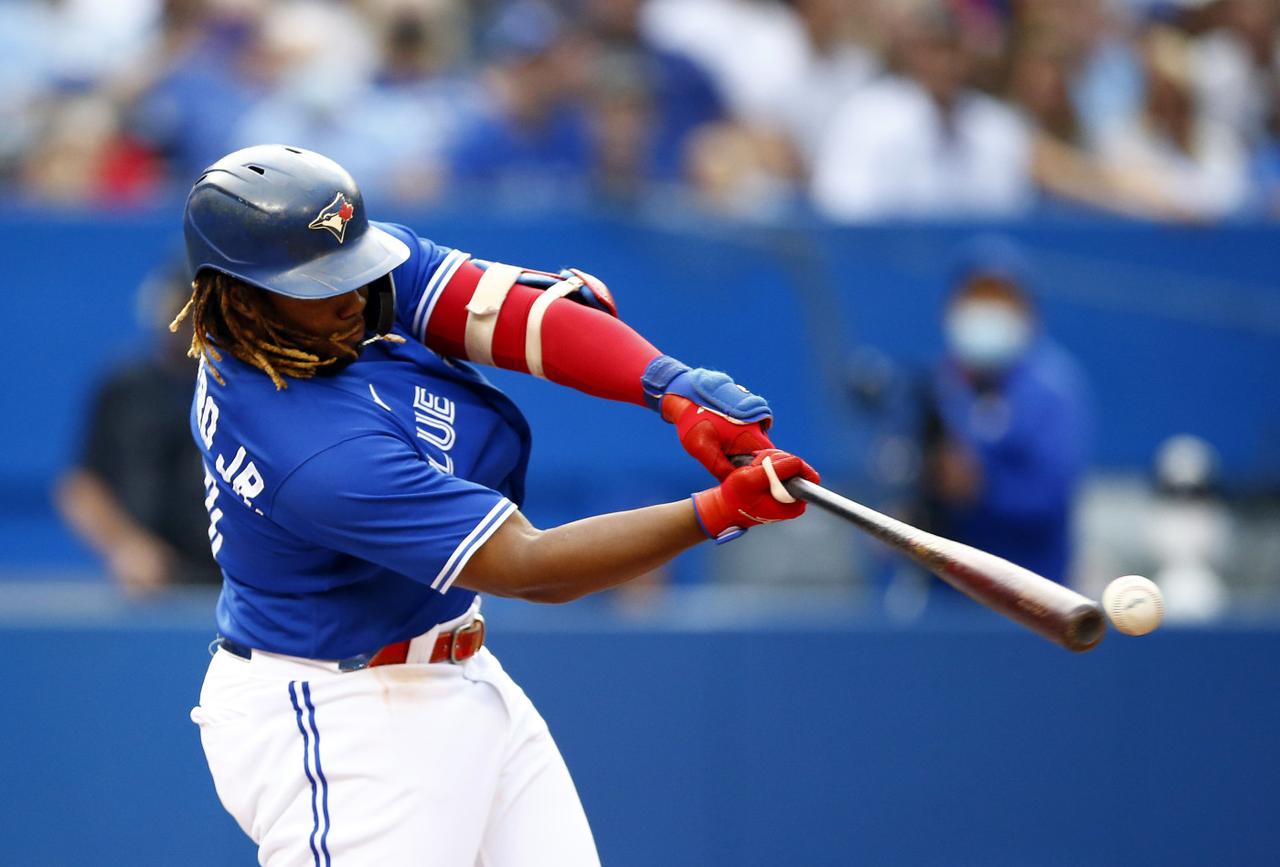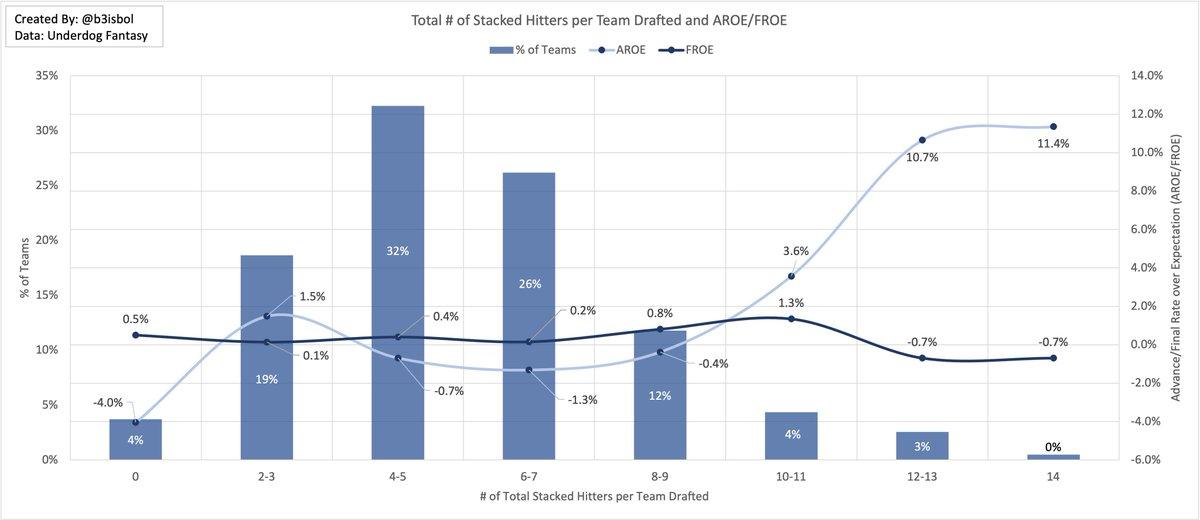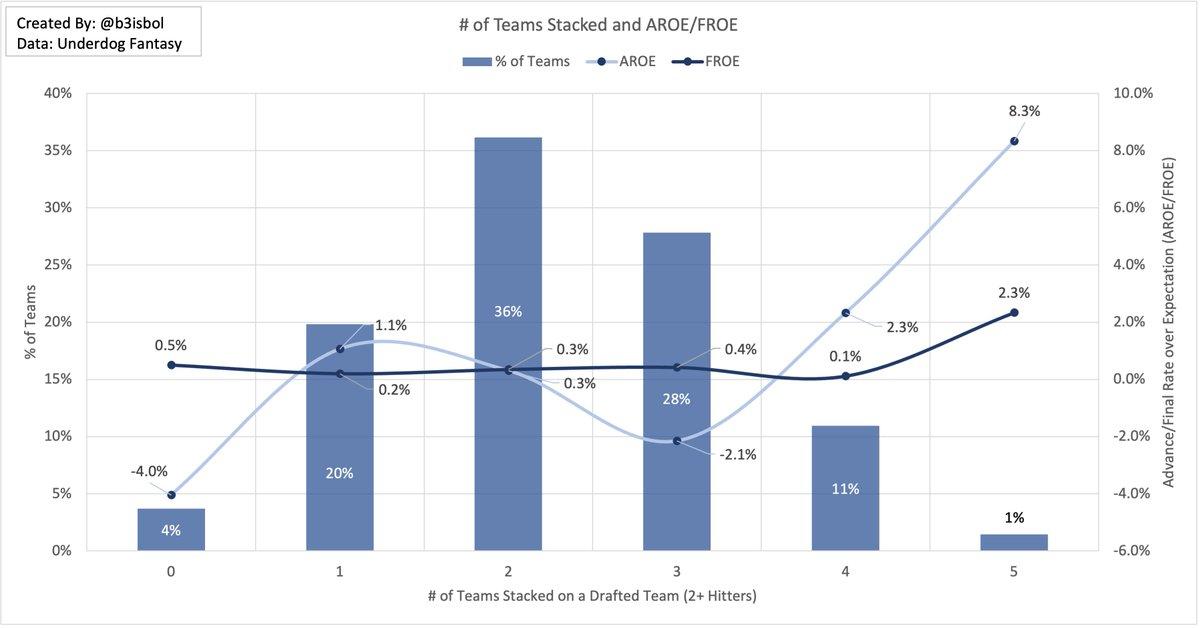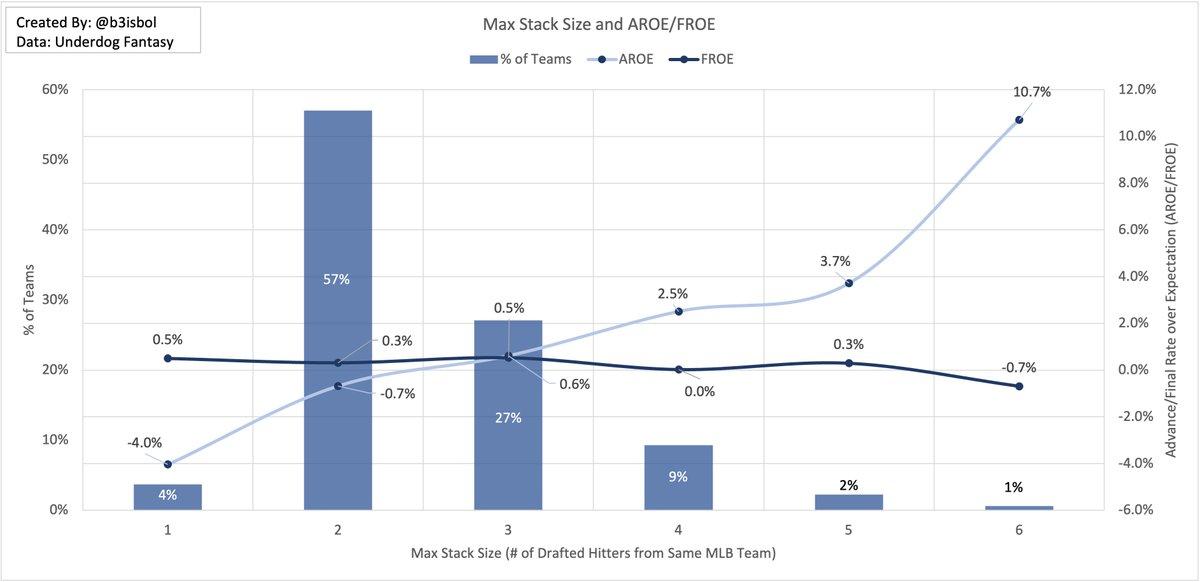Should You Stack Hitters on Underdog Fantasy?

Next to roster construction, deciding whether or not to stack hitters is often the first question a lot of drafters face when playing MLB Best Ball on Underdog Fantasy.
For those unfamiliar, "stacking" refers to drafting multiple players from the same team (or game). It was popularized in daily fantasy sports (DFS) since it optimizes upside. Let's say the Dodgers are playing the Rockies in Coors Field. If you make a lineup with multiple players from that game, and it winds up being very high scoring, then you're likely going to score very well. It's viewed as being "worth the risk" in large field tournaments.
The difference with Best Ball is that the weekly scoring periods weaken correlation. It's also different than football where stacking a QB and his pass catchers has immediate correlation. Still, if a MLB team has a surplus of games in a given week, and that offense has a high-scoring week, it stands to reason that it would be beneficial to incorporate stacks into our Best Ball squads. But does the data support that theory?
Reach out on Twitter with questions anytime, @toomuchtuma.
First things first, mega shoutout to my guy @b3isbol on Twitter, who created the charts you're going to see below. This is a must-follow account for anyone seriously playing MLB Best Ball on UD. All the data is from last year's marquee tournament, "The Dinger."
We'll start by looking at how well teams did when stacking hitters. As a reminder AROE stands for "Advanced Rate Over Expectation" and measures how likely UD teams were to advance out of the regular season and into the playoffs. FROE stands for "Finals Rate Over Expectation" and measures how likely teams were to then advance to the final round.

The total number of stacked hitters includes any situation where your Underdog team has 2+ bats from one MLB team.
For example, rostering 3 Astros, 3 Yankees, and 2 Dodgers would equal 8 total stacked hitters.
As you can tell in the chart above, most Underdog drafters (55%) stacked less than 6 total hitters. The AROE line stays mostly flat until it reaches 10+ hitters, and then it spikes at 12+.
This is a good sign for stacking in general, but there are two caveats to mention. First, the sample of teams that stacked double digit hitters is very small. Secondly, we don't know who these stacks included. For instance, did the teams with such high AROEs have Aaron Judge / Paul Goldschmidt stacks? Because that would skew the data. We'll put in a pin in this for now and circle back. (Also note that having a full unstacked team had the lowest AROE on the chart).

Up next we'll look at how well Underdog teams did by analyzing the number of MLB teams they stacked.
Here we see that stacking 4 or 5 teams did the best by AROE, but that the 5-team sample was incredibly small. When examining FROE, the line was flat outside of 5-team stacks (same small sample).
It's hard to have any definitive takeaways when AROE had a negative trend when moving from 1 to 3 stacked teams. Let's put a pin in this too.

The final graph for us describes "max stack size", which only measures the size of the largest stack on your Underdog roster.
Incredibly, 61% of drafters had only 2 hitter stacks or no stacks at all. This is surprising based on the conversations I was seeing around stacking last offseason.
As for how the results shook out, AROE showed a steady upward trend as the stack size grew! Meanwhile, FROE remained consistent throughout.
Conclusion
If we ignore sample size and only subscribe to the biggest edges that AROE suggests, that means we would:
Stack 10+ total hitters
Stack 4-5 teams total
Have a "max" stack of 4-5 hitters
As mentioned after the first chart's analysis, I don't think these rules should be taken as gospel. Whereas our study of roster construction and late-round pitchers feels conclusive, these findings still leave us with some questions.
It needs to be emphasized how small the sample size was of the datasets that did so well by AROE. Was this because those were Judge stacks? Was it because so few Underdog drafters were stacking? We can't be certain.
Additionally, following all the "AROE guidelines" could lead to suboptimal drafting. As my man @D4RKSH33P_ described it, drafting for these stacking guidelines seems like a chore to do (PS he's another must-follow account for serious UD MLB players).
Based on the findings, I'd describe stacking as an overall positive that drafters should embrace when the right situation emerges. It can be used as a tiebreaker if you're between 2 players and already have 1-2 players from one of their teams. Also if you're a "volume drafter", totaling 100+ drafts on Underdog, then yeah it's okay to go out of your way and get some exposure to bigger "max stacks."
It shouldn't be seen as a requirement to always be loading up on 4-5 player stacks, however. Instead, a bunch of 2-3 player "mini stacks" seems like the right approach. Of course, stacking the right teams and players is important too. In a future piece I'll be studying the schedule to see what (if any) opportunities present themselves.
ONE FINAL NOTE.
The Underdog teams with the biggest stacks also drafted the most hitters. This means they drafted fewer pitchers, which reinforces the idea that A) aces are undervalued and B) late-round pitchers are a trap.
Stacking shouldn't be viewed as "I need Yordan, Altuve, Bregman, and Peña." That would be nice to have, but not at the expense of understanding outfield scarcity or building a starting rotation that can consistently pitch deep into games, all the way into mid-September.
Take your 6 starters early-ish and use the end-game of drafts to take advantage of the additional roster spots left over for hitters. More roster spots for hitters = more chances for mini stacks. And perhaps this is part of the reason stacked teams did so well.